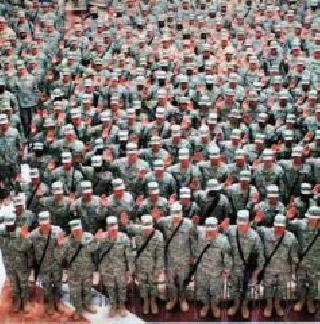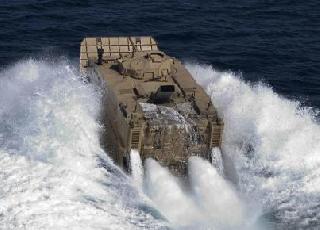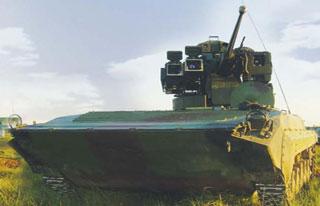
Reduction in the size of US Army and Marine Corps will be part of the country's defence budget cut.
WASHINGTON (PTI): Weighed down by cash-crunch, the US Defense Department has announced a massive financial restructuring, squeezing its budget by $78 billion in the next five years and ordering substantial reduction in the size of its Army and Marine corps.
Engaged in what seem like never-ending wars in Iraq and Afghanistan, where massive funds have flowed in the past decade, the Pentagon has decided to slash its budget for the first time in over 10 years. The last time Pentagon's budget was cut was in 1998.
"They are more important than ever at a time of extreme fiscal duress, when budget pressures and scrutiny fall on all areas of government, including defense," Defense Secretary Robert Gates Gates told reporters at a Pentagon briefing.
"When every dollar spent on excess overhead or unneeded programmes, such as the extra engine for the JSF, there's a dollar not available to support our troops and prepare for threats on the horizon," he said.
The spending-cuts of $78 billion have been coupled by a plan of cost-saving of up to $100 billion, and is aimed at helping the US tide over its massive deficit.
"This plan represents, in my view, the minimum level of defense spending that is necessary, given the complex and unpredictable array of security challenges the United States faces around the globe: global terrorist networks, rising military powers, nuclear-armed rogue states, and much, much more," Gates said as he spelled out the details of his new programme of cuts and savings.
However, Gates asserted that the US would continue to maintain its military strike advantages in the world.
"When it comes to global reach and striking power, the gap between the US military and the rest of the world, including our biggest potential rivals, will continue to be vast, and in some key areas will grow even wider," he said.
The plan envisages reducing the number of troops from the Army and Marine Corps by 47,000 starting 2015 when the Afghan forces are scheduled to take over the security mission.
This would save more than $6 billion.
The Air Force, meanwhile, has proposed efficiency measures that will total to $34 billion over five years.
Among those proposals are consolidating two air-operations centres in the US and two in Europe and consolidating three numbered Air Force staffs to save $500 million by reducing fuel and energy consumption within the Air Mobility Command.
It also includes improving depot and supply-chain business processes to sustain weapons systems, thus improving readiness at lower cost and reducing the cost of communications infrastructure by 25 per cent.
"This department simply cannot risk continuing down the same path where our investment priorities, bureaucratic habits and lax attitudes toward costs are increasingly divorced from the real threats of today, the growing perils of tomorrow and the nation's grim financial outlook," Gates said.
The Army, on the other hand, has proposed $29 billion in savings over the five years.
These include reducing manning by more than thousand positions by eliminating unnecessary task forces and consolidating six installation-management commands into four; saving $1.4 billion in military construction costs by sustaining existing facilities, and beginning consolidating the services' e-mail infrastructure and data centres, which should save $500 million over five years.
Similarly the Department of the Navy proposed savings of more than $35 billion.
Some of their measures include reducing manpower ashore and reassigning 6,000 personnel to operational missions at sea, besides using multi-year procurement to save more than $1.3 billion on the purchase of new airborne surveillance, jamming and fighter aircraft.
It also lays down disestablishing staffs for submarine patrol aircraft and the Destroyer squadrons plus the staff of one carrier strike group.
In addition to this the Department-wise review of the spending clubbed with a government-wide freeze on civilian salaries would yield about $54 billion in additional savings, Gates said.
A number of changes approved by Gates include downsizing the new intelligence organisations that have grown up around a number of the combatant commands in recent years, most of which are not directly engaged in the post-9/11 military conflicts.
"In place of having a large, permanent, organic apparatus, staffed on a wartime level, the department will transition to an arrangement that can surge intelligence support as needed from the Defense Intelligence Agency.
"Review also found that many intelligence organisations across the department and among military services focus on counterterrorism and terrorism finance.
"We will consolidate the various redundant programmes into two task forces located within DIA," he said.
Gates has also approved the elimination of more than a hundred general-officer and flag-officer positions out of the roughly 900 currently on the books.
Noting that it is also no longer necessary to retain four-star service component headquarters for the Army, Navy and Air Force in European Command, he said these will be reduced to the three-star level, with concurrent streamlining in the headquarters and personnel staff.
"The budget proposal anticipates a total reduction of roughly USD 78 billion to the five-year defense plan submitted last year. Even with this top-line reduction, we were able to adhere to the original intent of the reform initiative and permit the military services to keep and reinvest the roughly hundred billion dollars they identified for savings," he said.
 Previous Article
Previous Article Next Article
Next Article













The Indian Air Force, in its flight trials evaluation report submitted before the Defence Ministry l..
view articleAn insight into the Medium Multi-Role Combat Aircraft competition...
view articleSky enthusiasts can now spot the International Space Station (ISS) commanded by Indian-American astr..
view article